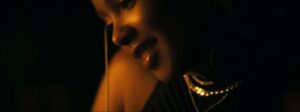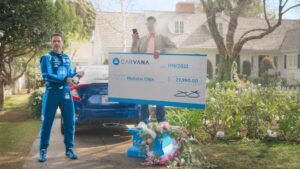Finely Sliced: Building Emotional Foundations with Catie Cacci
TBD Post’s editor Catie Cacci chats with Little Black Book on building emotional foundations. Q> The first cut is the deepest: how do you like to start an editing project? Catie> I always start an edit by watching down all the footage and marking things I like. Even if an assistant has helped organise and…

Finely Sliced: Building Emotional Foundations with Catie Cacci
TBD Post’s editor Catie Cacci chats with Little Black Book on building emotional foundations.
Q> The first cut is the deepest: how do you like to start an editing project?
Catie> I always start an edit by watching down all the footage and marking things I like. Even if an assistant has helped organise and notated the selects from set, I still like to familiarise myself with every option. This helps me connect more with the director’s intention and pick up on different nuances that may not be obvious if I only watch a select few takes. For documentary style projects I find it even more important to have intimate knowledge of the footage…
Q> Non-editors often think of editing just in technical terms but it’s integral to the emotion and mood of a film. How did you develop that side of your craft?
Catie> Before a project begins one of the first discussions I have with filmmakers is about the emotional foundation of the project. Understanding the emotion and mood are how I connect deeper to the content and the editing process. Growing up, my family went to the theatre a lot; and through films, musicals, and the opera I would forget about reality for a moment and only care about what was happening on stage. The stories were dramatic and emotional; I was enraptured by how the performances made me feel. By continuing to study film, music, and art, I am always building on how to emotionally connect through story.
Q> How important is an understanding of story and the mechanics of story?
Catie> It’s very important! If you understand the mechanics of story, then you can challenge how those mechanics are implemented.
Q> Rhythm and a sense of musicality seem to be intrinsic to good editing (even when it’s a film without actual music) – how do you think about the rhythm side of editing, how do you feel out the beats of a scene or a spot? And do you like to cut to music?
Catie> I believe editing creates a rhythm, with or without music, and this pacing is developed by instinct and emotion. By creating this pacing I can create a stronger connection emotionally and intellectually to the audience. I do enjoy cutting to music and having the musicality determine visual timing but sometimes that timing might even be motivated by silence, and it’s through this use of sound and silence that can be really engaging.

Q> Tell us about a recent editing project that involved some interesting creative challenges.
Catie> Recently I edited a campaign where the creative team was in another country and time zone. Remote editing has increased since the beginning of the pandemic, and it’s been a learning process as we’ve developed ways to work within this new creative structure. It’s also broadened the pool of people we can work with because remote work is now possible in this creative landscape. Which is awesome! The challenge during this past project happened after I created my first cuts and the creative team only had time to comment on postings. When this happens early in a job, I feel like it impedes the collaborative process that I enjoy so much. Text comments can be misinterpreted and quick calls can sometimes create more questions. I prefer remote sessions treated and scheduled like we’re in the room together, and it was not until we had one of these sessions where I felt like we were back in the creative zone, collaborating and flowing in the edit. You just feel more in-sync with one another, mentally and creatively.
Q> How important is your relationship with the director and how do you approach difficult conversations when there is a creative difference of opinion?
Catie> I love collaboration. Trust between the director and myself is the most important part of that relationship. If we establish trust then when we have any creative differences those conversations are not difficult but are actually constructive. In the end my idea may not be the path we take going forward but the confidence in our creative collaboration allows for those conversations.
Q> In the US we know that editors are much more heavily involved across the post production process than in Europe – what’s your favourite part of that side of the job?
Catie> I enjoy being a part of all post processes, but I especially enjoy being included in the music. The composer plays an important role in the storytelling process and can enhance or distract from the emotional tone of a scene with their music. I love being involved in that part of the process.
Q> What’s harder to cut around – too much material or not enough?
Catie> Not enough material is much more challenging. Then you have to figure out how to make people care with your limited material. This could be a fun challenge because you might come up with a creative technique to work with your limitations or it could be extremely frustrating.
Q> Which commercial projects are you proudest of and why?
Catie> I enjoyed working on the Enchanted Garden spot for Crocs. After talking with the director and the creative team, I was given freedom to develop an ethereal garden vibe for Natalie Dormer to explore. Working with various camera formats was fun and creatively fulfilling.
The creative duo Ben/Dave direct some funny content, and I was excited to work on a spot for EA Sports starring Marshawn Lynch as a fortune teller. It’s fun working on comedy spots because pacing and delivery determine whether that comedy lands. Ben/Dave are encouraging collaborators and want to see what I bring to the edit before we review cuts together. Together we added touches that made this spot playful and unique.
I’m also proud of Tootsie, a short documentary I edited with The Bear for Yeti. My first pass was an inspiring look at Tootsie, who is a pit master at Snow’s BBQ in Lexington, TX, who at the time was 80 years old. After we presented this pass to the agency they asked if we could make her feel more “bad ass.” I loved that feedback, and immediately tackled my edit with a new approach to not only tell Tootsie’s incredible story but to make the audience feel more regard for Tootsie’s strength and determination in this tough environment.
Q> There are so many different platforms for film content now, and even in advertising something can last anything from a few seconds to a couple of hours. As an editor, are you seeing a change in the kind of projects you’re getting from brands and agencies?
Catie> Different platforms are creating more ways to deliver ideas and stories. We now look at these spots and brands more intimately, frame by frame, when presented with a short 15 second or 6 second deliverable. You really consider the direction and what each frame represents in those short pieces. With a 30 second spot you still consider each frame, but you have more time to deliver the story or message. On the other hand the longer deliverables, like :60 or :90, allow more creative freedom and can now have a longer life online.
Q> Who are your editing heroes and why? What films or spots epitomise good editing for you?
Catie> Thelma Schoonmaker is an absolute editing hero. Her longtime relationship with Martin Scorsese has created some of my favourite films, like Raging Bull, Goodfellas, and Casino. Their ability to compress time while creating a mood and feeling within the spaces we are experiencing is exceptional.
Q> How does editing in the commercial world differ from the film world and TV world?
Catie> In the commercial world I use the creative boards, scripts, and preliminary discussions to determine what story we are trying to tell and what our goal is. Often the message is based on the visual aesthetic and language the creative team has developed for the brand. Together the creative team and I will use our, usually short, amount of time together to achieve this purpose. It is part of my job to maintain and cultivate those relationships since our times together are not as long as in the film and TV world. In those instances, we have more time to form our creative relationship. Film and TV edits are determined more by the overall story and character motivations, which ultimately develop the pacing and approach.

Q> Have you noticed any trends or changes in commercial editing over recent years?
Catie> I feel like there is a cinematic trend in commercials where we’re seeing longer form visual stories connecting us to real people in addition to the shorter broadcasted spots and socials. Not having as many limitations in social media allows the creative freedom to create a deeper understanding of the stories we are telling and the human beings we are connecting. I’ve seen this with documentary style commercials as well as montage and music driven spots.